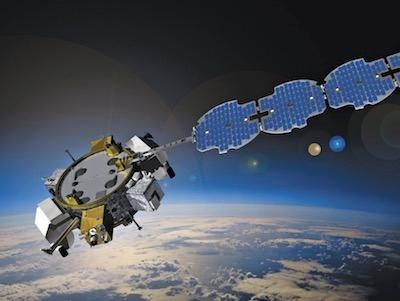Tue, Apr 17, 2018
EAGLE Launched Saturday From Cape Canaveral Air Force Station In Florida
Orbital ATK designed the EAGLE (ESPA Augmented Geostationary Laboratory Experiment) experimental satellite for the U.S. Air Force’s AFSPC-11 mission that successfully launched on United Launch Alliance’s Atlas V vehicle April 14 from Cape Canaveral Air Force Station, Florida. The AFSCPC-11 mission included a second company designed satellite, Mycroft, which is among several Department of Defense experiments hosted on the EAGLE platform as separate payloads.

The EAGLE and Mycroft satellites are based on the company’s ESPAStar™ and ESPASat™ products, which provide modular, cost-effective and highly capable infrastructure resources for hosting technology development and operational payloads. The Orbital ATK-designed EAGLE satellite is the first spacecraft based on the company’s innovative ESPAStar platform. The ESPAStar vehicle can accommodate any combination of up to six hosted or 12 separable, free-flyer payloads in low and geosynchronous orbit and is built to provide an even greater level of access to space. Orbital ATK designed and delivered the EAGLE satellite under a contract with the U.S. Air Force Research Laboratory (AFRL) Space Vehicles Directorate.
After a successful separation from the launch vehicle, EAGLE is hosting several Department of Defense payloads, including Mycroft, the second Orbital ATK-designed satellite to be deployed on the mission. Mycroft, a separable, fly-away experiment, utilized the company’s ESPASat platform for its flight. ESPASat is designed as an affordable GEO bus that can be launched as a secondary payload from an ESPAStar platform.
“Orbital ATK is proud to partner with the U.S. Air Force on the EAGLE and Mycroft missions,” said Chris Long, Vice President, National Security Systems at Orbital ATK. “Our unique capabilities to host separating and non-separating payloads represent a turning point in affordable access to space for small satellites and payloads.”
(Image provided with Orbital ATK news release)
More News
Pilot Also Reported That Due To A Fuel Leak, The Auxiliary Fuel Tanks Were Not Used On June 4, 2025, at 13:41 eastern daylight time, a Piper PA-23, N2109P, was substantially damage>[...]
Have A Story That NEEDS To Be Featured On Aero-News? Here’s How To Submit A Story To Our Team Some of the greatest new stories ANN has ever covered have been submitted by our>[...]
From 2023 (YouTube Edition): Reflections on War’s Collective Lessons and Cyclical Nature The exigencies of war ought be colorblind. Inane social-constructs the likes of racis>[...]
Aero Linx: Colorado Pilots Association (CPA) Colorado Pilots Association was incorporated as a Colorado Nonprofit Corporation in 1972. It is a statewide organization with over 700 >[...]
High Speed Taxiway A long radius taxiway designed and provided with lighting or marking to define the path of aircraft, traveling at high speed (up to 60 knots), from the runway ce>[...]
 NTSB Prelim: Piper PA-23
NTSB Prelim: Piper PA-23 ANN FAQ: Submit a News Story!
ANN FAQ: Submit a News Story! Classic Aero-TV: One Mans Vietnam
Classic Aero-TV: One Mans Vietnam ANN's Daily Aero-Linx (07.03.25)
ANN's Daily Aero-Linx (07.03.25) ANN's Daily Aero-Term (07.03.25): High Speed Taxiway
ANN's Daily Aero-Term (07.03.25): High Speed Taxiway



